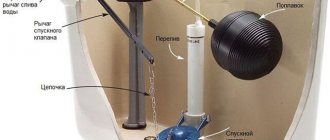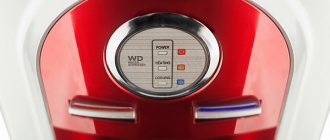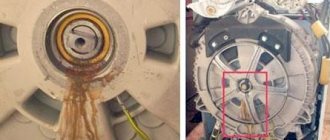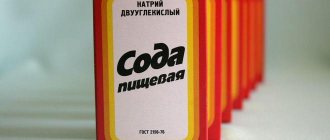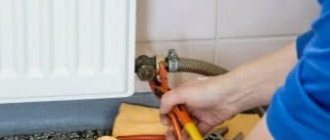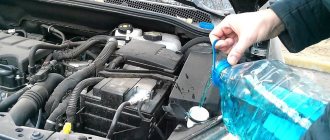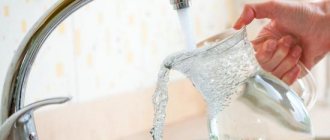Not only apartment owners are faced with the fact that brown water flows from the tap. Owners of private houses are also familiar with this problem, although they do not use the services of public utilities, but have individual wells. There are several ways you can easily deal with the problem of rusty water. This article will help you figure it all out.
What is rust?
Oxidation of metal is called rust. There are 2 reasons why such an impurity may appear in water:
- increased level of iron in the water itself – 0.35 mg/l or more;
- The pipelines are quite damaged and are made of metal parts.
Before deciding on a method for purifying rusty water, you must first find the causes of metallic sediment. We will have to solve the problem thoroughly if the cause is in the pipelines themselves. Then all obsolete parts will have to be completely replaced. In this case, other methods of water purification will be ineffective.
Causes of rust
The appearance of cloudiness and a yellowish tint may not appear immediately, but after a few days, and cleaning is necessary.
Reasons for rusty water in the pool:
- increased content of iron and magnesium in the source of intake;
- high acidity of water, which promotes the formation of rust;
- old metal pipes.
Any manifestation of a problem requires an immediate response, since swimming in such water becomes unpleasant and dangerous to health.
Why do you need to purify water from rust?
Even if rusty water is not used as drinking water, its purification is required in any case. This is due to the following reasons:
- It is unpleasant to even take a bath or shower in such water, let alone drink it. First of all, hair and skin suffer from excess iron, so contact with such water is harmful.
- Clothes washed in rusty water look stale, unkempt, have some stains and take on a yellow tint.
- This water causes yellow spots to form on the inner surface of the toilet and sink. Then it is not always easy to remove them.
- The operating time of all household appliances is significantly reduced and their functioning is disrupted. Boilers, heating boilers, washing machines, dishwashers, and geysers quickly fail due to contact with rusty water.
- The service life of dividers, mixers, pipes, taps and all plumbing fixtures is also significantly reduced. This is due to the fact that iron settles on their inner walls.
- The water becomes cloudy, opaque, and has an unpleasant tint. For particularly squeamish people, all this causes some inconvenience.
- It's not very pleasant when water has a metallic taste.
Causes of rusty water
There are several factors that can change the color and smell of produced water:
- Changes in the soil. The composition of the liquid changes when aquifers or solid layers are displaced.
- Insufficient well depth. The extracted resource is exposed to atmospheric factors, such as rainwater runoff or drought.
- Mixing of deep waters with high water. The quality of the liquid can deteriorate when interacting with groundwater lying close to the surface.
- Entry of foreign objects. Contaminants accidentally enter the well in the absence of a protective cap.
- High level of iron impurities. Substances react with oxygen, forming compounds that give the liquid its corresponding color.
- Clogged pipes causing corrosion. The latter is the reason for the penetration of iron oxide, which has a yellowish color, into the water. Depending on the content of this element, the liquid may take on a light yellow, orange or brown tint.
Water purification methods
There are several options to solve the problem. Before you begin purifying water from rust, you need to familiarize yourself with these options, the advantages and disadvantages of each of them, and the cost of using one or another option. Based on the requirements for water quality and a set of criteria, it is necessary to select the most effective and simple cleaning method.
There are currently 3 main ways to purify water from rust impurities:
- Advocacy.
- Using special filters.
- The problem of rusty water and the presence of other foreign impurities in it is solved by installing special equipment.
Countryside and suburbs
Not only residents of apartment buildings, but also residents of the private sector, even those with an individual well, face problems. Therefore, methods of water purification at home are relevant for everyone.
Water with rust can also come out of a well. A third of the samples reveal dangerous health indicators. Often, samples in underground and open water bodies do not meet the requirements. There is a critical shortage of drinking water. Therefore, in country houses, wells and boreholes serve as such sources.
Water settling
The most economical way is to settle the water. But this is also the longest option. This procedure is performed as follows:
- Pour water into large containers.
- It settles from several hours to several days. The time for this process depends on the degree of contamination and the volume of water.
- Water is used for its intended purpose.
Advantages of the method:
- Profitability – from a financial point of view.
- This method is environmentally friendly.
Flaws:
- The result comes after a long time.
- This method is not suitable for servicing domestic needs, where large volumes of water are required.
- Water purification occurs only from large and visible particles.
How to properly settle water?
Water settling is the most economical, but at the same time long-lasting way to solve the problem of how to clean rusty water. To perform the procedure correctly:
- Pour water into large containers.
- Leave for a while - from a couple of hours to several days. The duration depends on the amount of water and the degree of its contamination.
- Use as directed.
Advantages of settling water:
- Beneficial from the financial side.
- Ecological purity of the method.
Minuses:
- Long wait for results.
- Not suitable for obtaining water in large volumes to serve all domestic needs.
- Water is purified only from visible, relatively large particles and only rust.
Using special filters
There is a more modern solution that allows you to deal with metal oxides in water - this is a rust filter. In form they are of the following types:
- Filter cartridges. Such devices are most often used for domestic purposes. They have porous internal cells that trap particles of foreign impurities. Passing through such a device, the water becomes clean.
- Devices with loose mass for washing. The filter layer in such devices is usually quartz sand. But there are other similar fillers. Impurities present in water, passing through such a device, are retained in the volume of the bulk substance. This method is used mainly in industry, where water must be filtered in large volumes.
The filter elements of these 2 groups differ in price, duration of use, simplicity and efficiency.
Filters also differ in place of application and installation method:
- Mesh. Used for rough water purification from large particles.
- Mesh with a lock for taps. With their help you can get rid of chlorine compounds. They are actively used in domestic conditions.
- Jugs. They mainly contain activated carbon. They are used to produce drinking water, which must be free of harmful substances, including rust.
The price for them directly depends on the amount of impurities from the purified water that rust filters can remove.
Types of plumbing systems and their features
High-quality purification of water from rust should consist of several stages - removal of large mechanical particles and elimination of colloidal suspensions.
For this purpose, filters of various designs are used.
Trunk
Main filters are installed on cold and hot water supply pipes .
They remove mechanical impurities, unpleasant odors and tastes from water.
Important! Purified water is necessary for the stable operation of some types of household appliances. High concentrations of mechanical particles and dissolved salts significantly reduce the working life of washing machines and dishwashers and shorten their trouble-free service life.
For more information about mainline filters, watch the video:
Mesh
This is a group of devices consisting of a brass body, inside of which a stainless steel mesh element is placed. The size of the mesh cells varies from 100 to 900 microns. The smaller the cell, the better the water is purified.
Among the advantages of mesh filters:
- relatively low price,
- resistance to pressure changes and high temperatures,
- good throughput,
- no operating costs.
Over time, the mesh becomes clogged with particles of rust and sand. But it is easy to clean from dirt. It is enough to rinse the mesh under a strong stream of water.
Prices for mesh filters start from 400 rubles . High-quality mesh filters are available from such well-known European manufacturers as BUGATTI, HERZ, HONEYWELL.
Cartridge
Cartridge main filters consist of a flask (housing) and a replaceable cartridge . They can be single-stage or multi-stage.
- Single-stage - inexpensive models that provide cleaning only from large particles of rust and other contaminants.
- Two-stage filters, in addition to a rough mechanical cleaning unit, are equipped with a carbon cartridge. It traps tiny particles of rust, as well as organic compounds and other contaminants.
- The three-stage filter is complemented by a flask with an ion exchange element. It removes iron, magnesium and calcium ions from water.
The cost of a cartridge filter depends on its performance, as well as the type of material from which the flasks and filter elements are made. The price range can be from 900 to 9000 rubles.
Flasks of inexpensive models are made of plastic. Stainless steel flasks are considered the most reliable and durable. The following companies offer an extensive line of cartridge filters:
- AQUAPHOR (Estonia),
- GEYSER (Russia),
- BRITA (Germany),
- ZEPTER (Sweden).
Automated filtration systems
Such water treatment systems are usually used in country cottages. They consist of a battery of universal flask housings with various filter media and an automatic control unit.
Each filter operates according to an individual program, which is selected depending on chemical parameters and water consumption.
Automation ensures periodic washing of filters and also optimizes water consumption.
The cost of an automated system depends on:
- its type (continuous action or with a break for regeneration),
- operating principle of the control unit (electronic or electromechanical),
- other parameters.
It is calculated individually at the design stage.
Jug type cleaners
The principle of operation of a jug filter is no different from flow-through models under the sink. Water is purified from harmful impurities by seeping through a layer of filter material.
But the jugs do not need to be connected to a water supply or a water tank.
To put the filter into working condition, just place it on the table and pour water. Cleaning will take a few minutes.
When choosing a filter jug, the following parameters are important:
- capacity (depending on the model, ranges from 1.5 to 6 liters)
- type of cartridge (regular, bactericidal, for hard water)
- cartridge resource (from 150 to 500 l)
- cartridge resource indicator (mechanical or electronic)
Attention! After the cartridge has exhausted its resource, it must be replaced with a new one. Otherwise, the contaminants accumulated in the filter will begin to flow into the drinking water.
The average cost of filter jugs ranges from 600 to 2000 rubles. These products are presented in the range of companies:
- Aquaphor (Estonia);
- Barrier (Russia);
- Brita (Germany);
- Geyser (Russia).
We recommend an article on the topic
Our recommendations: which is the best water filter pitcher?
Reverse osmosis systems
Reverse osmosis filters are used to obtain high-quality drinking water. Typically, they are installed under the kitchen sink and the outlet is connected to a separate tap or to a special mixer with two channels laid in one spout (for domestic and drinking water).
The filter element of a reverse osmosis unit is a semi-permeable membrane. It retains up to 98% of inorganic contaminants and organic substances, as well as pathogenic bacteria. Membrane filters, unlike cartridges, do not accumulate contaminants. Water with harmful substances dissolved in it is constantly washed down the drain.
The productivity of membrane filters is low and ranges from 0.3 to 1.5 liters per minute.
Therefore, osmotic devices are equipped with a storage tank . Its volume can range from 2 to 25 liters.
The osmotic block is only one of the purification stages. In addition to this, the system includes filtration elements for mechanical cleaning and a carbon cartridge.
The membrane, along with pollutants, also retains beneficial salts. Therefore, after purification, the water becomes tasteless . To correct this deficiency, it is passed through a mineralizer - a block filled with substances that saturate the water with useful mineral salts.
Interesting! When purchasing a reverse osmosis system, you can configure it individually, based on the physical and chemical parameters of the water. If desired, the filtration unit is supplemented with an ultraviolet lamp for disinfection.
The average cost of standard osmotic filters varies from 6,000 to 20,000 rubles. The price of blocks created to order can reach 30,000 rubles or more.
Among the manufacturers offering quality products at an affordable price:
- Barrier;
- Geyser;
- Aquapro (Taiwan).
Flow-through systems under the sink
Flow systems are characterized by high performance.
Unlike reverse osmosis systems, flow filters are cheaper, require less water, and do not require additional mineralization.
However, the quality of purification is slightly worse, but in most cases, with centralized basic water purification at the local water utility, such filters are sufficient.
The cost varies from 2-3 thousand rubles. up to 10-15,000 rubles and depends on the manufacturer, the number of cleaning stages, replaceable cartridges, build quality, etc.
The most popular manufacturers: Geyser, Barrier, Aquaphor.
Faucet attachments
Faucet attachments are compact filters that are installed on the kitchen faucet spout . They provide two stages of filtration: capture of mechanical particles and purification through activated carbon. Filter attachments can be removable or stationary.
In the first case, an adapter with an external thread is attached to the spout. A housing with filter elements is screwed onto it. The filter is used periodically to obtain drinking water. Stationary filters are permanently located on the spout.
To prevent drinking water from being wasted for domestic needs, such nozzles are equipped with an operating mode switch (“with cleaning” and “without cleaning”).
The advantages of filter attachments include ease of installation, compact size and affordable price - from 200 to 1500 rubles.
Important! In expensive models of nozzles, ion exchange resins, rather than activated carbon, may be used as a filter element. They not only purify water from chlorine and organic impurities, but also reduce its hardness.
Why do you need iron removal equipment?
Initially, let’s refute the most common myth that supposedly a reddish liquid will flow in those areas where iron ore is abundant and work is underway to mine it. Underground groundwater, flowing through a layer of a chemical element, does not absorb harmful impurities and is supplied to the consumer in a state that complies with SES standards. The culprit is pipelines made of metal, which we inherited from the Soviet Union. Wear and tear of the system leads to the appearance of so-called iron bacteria, which multiply in large numbers on the inner walls of the pipes. They become a source of saturation of the flow with iron in the form of small particles, in rare cases (almost never) with scale.
How to make a filter with your own hands
In this case, high technologies are not used, so if necessary, you can quite effectively filter the water through a variety of porous materials (gauze, cotton wool, paper, etc.). It is necessary to select the most successful filler, such as coal. In this case, a sandwich is created with alternating layers of it and separating fabrics or fiber structures. Let's look at specific effective cleaning methods.
Application of plastic bottle
Such a container in itself is almost a finished cartridge. If you fill a vessel with layers of coal and paper napkins, then after connecting the pressure to the neck, purer moisture will flow from a special hole made in the bottom. This design can be improved by placing the bottle in a large container so that the flow first passes through it from top to bottom, and then gradually rises through another container to the drain hole. The entire space is filled with various filter materials that you have in your home.
Making your own carbon barrier
Such raw materials have earned a reputation as a good adsorbent, but small particles are prone to leaching. Your task is to mechanically insulate each of the layers, using dense fabric, cotton wool, or any fibrous inert substances. As a result, you will receive not only purification from Fe2O, but also partial removal of other unwanted compounds.
Reliable cleaner for household needs
At home, it is quite possible to make a device that is not very beautiful, but effective and easy to maintain. You just have to put in more effort and be creative in the process.
The design is not fundamentally different from the factory versions. You just need to ensure tightness, easy connection of fittings and the ability to easily change the filler. The number of variations is endless.
water barrier
With due diligence, you will be able to make a flow device. The main problem here will be quite high pressure. Therefore, it is worth using special connecting nodes in the product. It is possible to make flasks for the filler yourself from large-diameter plastic pipes. Your task will be to repeat the factory version with a single or multi-stage cartridge unit.
The easiest way, of course, is to come to the store and pay money to purchase the goods. But in some situations, there is rust in the water from the well, but there are no retail outlets nearby. A way out of a difficult situation can always be found. Dare, show your imagination and you will succeed. To reinforce the material, watch the video:


